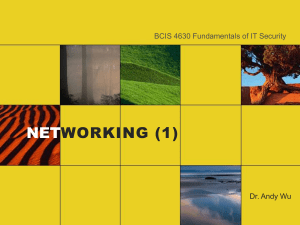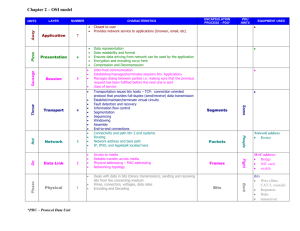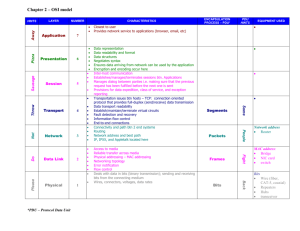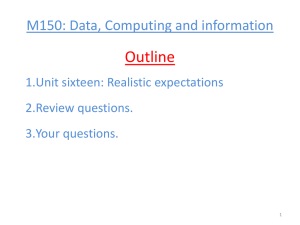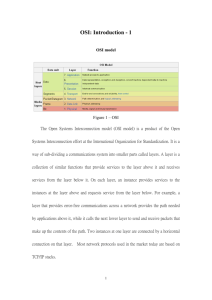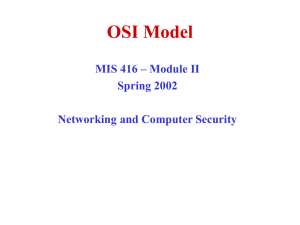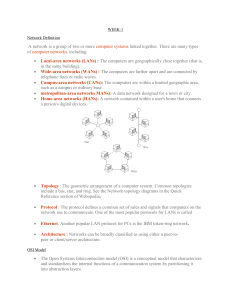The Open System Interconnection (OSI) Reference Model
advertisement
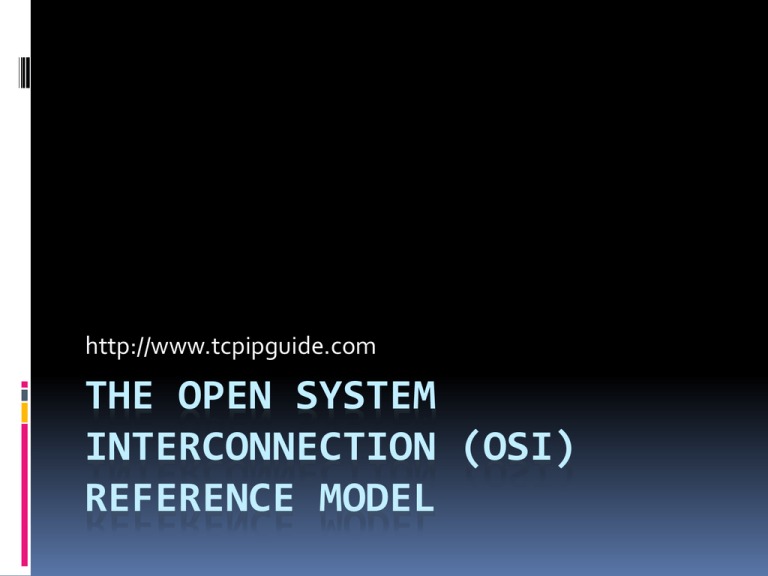
http://www.tcpipguide.com THE OPEN SYSTEM INTERCONNECTION (OSI) REFERENCE MODEL The Benefits of Networking Models A good analogy of a networking model is to that of an assembly line at a manufacturer. No company attempts to have one person build an entire car; even if they did, they wouldn't expect that individual to be able to learn how to do it all at once. The division of labor offers several advantages to a company that builds a complex product, such as an automobile. Generally speaking, these include the following: Training and Documentation: It is easier to explain how to build a complex system by breaking the process into smaller parts. Training can be done for a specific job without everyone needing to know how everything else works. Specialization: If everyone is responsible for doing every job, nobody gets enough experience to become an expert at anything. Through specialization, certain individuals develop expertise at particular jobs. A good analogy of a networking model is to that of an assembly line at a manufacturer. No company attempts to have one person build an entire car; even if they did, they wouldn't expect that individual to be able to learn how to do it all at once. The division of labor offers several advantages to a company that builds a complex product, such as an automobile. Generally speaking, these include the following: Easier Design Modification and Enhancement: Separating the automobile into systems, and particular jobs required to build those systems, makes it easier to make changes in the future. Without such divisions, it would be much more difficult to determine what the impact might be of a change, which would serve as a disincentive for innovation. Modularity: This is related to each of the items above. If the automobile's systems and manufacturing steps are broken down according to a sensible architecture or model, it becomes easier to interchange parts and procedures between vehicles. This saves time and money. OSI Reference Model Networking Layers, Sublayers and Layer Groupings OSI Reference Model Layer and Layer Groupings Lower Layers (Layers 1, 2, 3 and 4): The lower layers of the model—physical, data link, network and transport—are primarily concerned with the formatting, encoding and transmission of data over the network. They don't care that much about what the data is or what it is being used for, just about moving it around. They are implemented in both hardware and software, with the transition from hardware to software occurring as you proceed up from layer 1 to layer 4. Upper Layers (Layers 5, 6 and 7): The higher layers of the model—session, presentation and application—are the ones that are concerned primarily with interacting with the user, and implementing the applications that run over the network. The protocols that run at higher layers are less concerned with the low-level details of how data gets sent from one place to another; they rely on the lower layers to provide delivery of data. These layers are almost always implemented as software running on a computer or other hardware device. OSI Reference Model Layer Relationships and Terminology Each layer “N” provides services to layer “N+1” and uses the services of layer “N1”. Taking the example of layer three, the network layer, we see that it provides services to layer four, and uses services of layer two. From the standpoint of the network layer, the transport layer is layer “N+1” and the data link layer “N-1”. Interfaces: Vertical (Adjacent Layer) Communication OSI Reference Model Interfaces for Vertical Communication In OSI model terminology, an interface is a conduit for communication between adjacent layers in the layer stack. Protocols: Horizontal (Corresponding Layer) Communication The term “protocol” has many meanings; in the context of the OSI Reference Model, it refers specifically to software or hardware elements that accomplish communication between corresponding layers on two or more devices. For example, the Internet Protocol is said to be a layer 3 protocol because each device uses IP software to communicate at layer 3. The actual transmission and reception of data only occurs at the lowest, physical layer; higher-layer protocols communicate logically, by passing data down interfaces until it reaches layer 1, transmitting at layer 1, and then passing the data back up to the appropriate layer at the recipient. OSI Reference Model Protocols: Horizontal Communication Data Encapsulation, Protocol Data Units (PDUs) and Service Data Units (SDUs) OSI Reference Model Data Encapsulation Each protocol creates a protocol data unit (PDU) for transmission that includes headers required by that protocol and data to be transmitted. This data becomes the service data unit (SDU) of the next layer below it. This diagram shows a layer 7 PDU consisting of a layer 7 header (“L7H”) and application data. When this is passed to layer 6, it becomes a layer 6 SDU. The layer 6 protocol prepends to it a layer 6 header (“L6H”) to create a layer 6 PDU, which is passed to layer 5. The encapsulation process continues all the way down to layer 2, which creates a layer 2 PDU—in this case shown with both a header and a footer— that is converted to bits and sent at layer 1. OSI Reference Model PDU and SDU Encapsulation This example shows in more detail how OSI PDUs and SDUs are created and encapsulated. A TCP segment (layer 4 PDU) becomes a layer 3 SDU, which is encapsulated into a layer 3 PDU through the addition of an IP header. This becomes the payload of an Ethernet frame, which is a layer 2 PDU containing an Ethernet header, layer 2 SDU (the IP datagram) and Ethernet footer. The receiving device extracts the IP datagram from the Ethernet header and passes it to layer 3; the IP software extracts the TCP segment and passes it up to the TCP software. Indirect Device Connection and Message Routing Message Routing in the OSI Reference Model This diagram shows how routing is accomplished conceptually in the OSI model. The intermediate device connects the networks of the message transmitter and recipient. When data is sent, it is passed up to the network layer on the intermediate device, where it is repackaged and sent back down the stack for the next leg of its transmission. Note that the intermediate device actually has two different layer 1 and 2 implementations; one for the interface to each network. Also note that while the layer 3 protocol must be the same across the internetwork, each network can use different technologies at layers 1 and 2. OSI Reference Model Layer Summary OSI Reference Model Layer Summary Group Layer Name Key Responsibilities Data Type Handled Physical Encoding and Signaling; Physical Data Transmission; Hardware Specifications; Topology and Design Bits Data Link Logical Link Control; Media Access Control; Data Framing; Addressing; Error Detection and Handling; Defining Requirements of Physical Layer Frames Network Logical Addressing; Routing; Datagram Encapsulation; Fragmentation and Reassembly; Error Handling and Diagnostics Datagrams / Packets 4 Transport Process-Level Addressing; Multiplexing/Demultiplexing; Connections; Segmentation and Reassembly; Acknowledgments and Retransmissions; Flow Control Datagrams / Segments 5 Session 6 Presentation 7 Application # 1 2 Lower Layers 3 Upper Layers Scope Electrical or light (Physical layers of most of signals sent between the technologies listed for the local devices data link layer) Low-level data messages between local devices User Application Services Communication between software processes Sessions User Data IEEE 802.2 LLC, Ethernet Family; Token Ring; FDDI and CDDI; IEEE 802.11 (WLAN, Wi-Fi); HomePNA; HomeRF; ATM; SLIP and PPP IP; IPv6; IP NAT; IPsec; Messages between Mobile IP; ICMP; IPX; DLC; local or remote PLP; Routing protocols such devices as RIP and BGP Sessions between local or remote devices Data Translation; Compression Encoded User Application data and Encryption Data representations Session Establishment, Management and Termination Common Protocols and Technologies Application data TCP and UDP; SPX; NetBEUI/NBF NetBIOS, Sockets, Named Pipes, RPC SSL; Shells and Redirectors; MIME DNS; NFS; BOOTP; DHCP; SNMP; RMON; FTP; TFTP; SMTP; POP3; IMAP; NNTP; HTTP; Telnet Class group assignment Prepare class presentation explaining examples protocol of each of the 7 (seven) layer by answering at least the following questions : What is it (protocol) How it functions How it relates to its upper and lower protocol How it relates/communicates with peer layer For what purpose is it usualy created for
